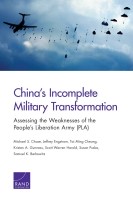| 来源类型 | Research Reports
|
| 规范类型 | 报告
|
| ISBN | 9780833088307
|
| 来源ID | RR-893-USCC
|
| China's Incomplete Military Transformation: Assessing the Weaknesses of the People's Liberation Army (PLA) |
| Michael S. Chase; Jeffrey Engstrom; Tai Ming Cheung; Kristen Gunness; Scott W. Harold; Susan Puska; Samuel K. Berkowitz
|
| 发表日期 | 2015
|
| 出版年 | 2015
|
| 页码 | 200
|
| 语种 | 英语
|
| 结论 |
The People's Liberation Army (PLA) Is Becoming More Professional and More Capable - The PLA's capabilities aimed at deterring or, if necessary, countering U.S. military intervention in the Asia-Pacific region, including systems designed to hold U.S. military bases, aircraft carriers, space systems, and computer networks at risk have improved markedly.
This Transformation Is, However, Incomplete - Chinese military media and PLA books and journal articles discuss the PLA's problems at length.
- The PLA's senior leadership speaks of the "two incompatibles," perceived gaps between current PLA capabilities and the demands of winning a local war under informatized conditions and successfully executing the PLA's other missions.
PLA's Organizational Structure and Human Capital Issues Are Sources of Concern - The PLA's organizational structure appears to be an obstacle to its reaching the level of joint operations to which it aspires.
- The human capital shortcomings include such problems as insufficient education and technical proficiency and rampant corruption.
The PLA Also Has Shortfalls in Its Combat Capabilities - PLA publications highlight shortcomings in joint operations capabilities, training, and combat support and combat service support functions.
- PLA is concerned about the integration of increasingly complex weapons and equipment, the associated training, the level of mastery of critical capabilities, insufficient numbers of key enablers and protecting China's growing interests in space and the electromagnetic spectrum.
- China's defense industry still suffers from a number of problems that have yet to be resolved, including widespread corruption, lack of competition, delays and cost overruns, and quality control issues.
|
| 摘要 |
- Analysts should devote greater attention to studying the PLA's weaknesses — and its self-assessments of its shortcomings — to inform assessments of the future direction of PLA modernization, support the development of a military-to-military relationship with China that advances U.S. interests, improve the ability of the United States and its allies and partners to deter China from using force or coercion to resolve disputes, and devise strategies for countering Chinese use of force if deterrence fails.
|
| 主题 | China
; Global Security
; Human Capital Investments
; Military Transformation
; Warfare and Military Operations
; Workforce Management
|
| URL | https://www.rand.org/pubs/research_reports/RR893.html
|
| 来源智库 | RAND Corporation (United States)
|
| 资源类型 | 智库出版物
|
| 条目标识符 | http://119.78.100.153/handle/2XGU8XDN/108098
|
推荐引用方式
GB/T 7714 |
Michael S. Chase,Jeffrey Engstrom,Tai Ming Cheung,et al. China's Incomplete Military Transformation: Assessing the Weaknesses of the People's Liberation Army (PLA). 2015.
|
|
文件名:
|
x1495316343146.jpg
|
|
格式:
|
JPEG
|

|
文件名:
|
RAND_RR893.pdf
|
|
格式:
|
Adobe PDF
|
除非特别说明,本系统中所有内容都受版权保护,并保留所有权利。